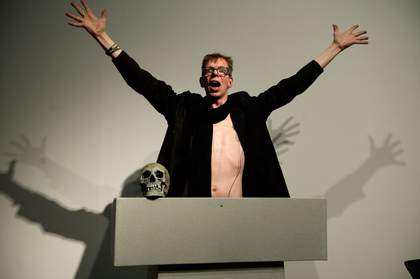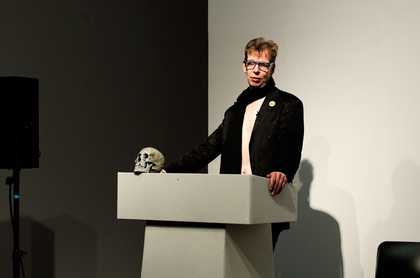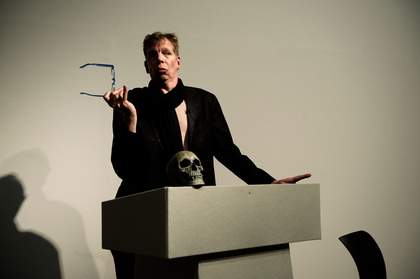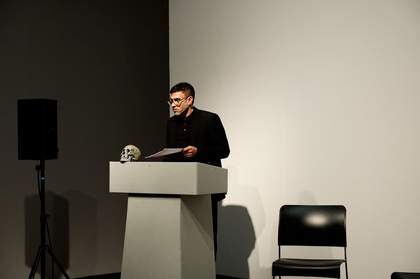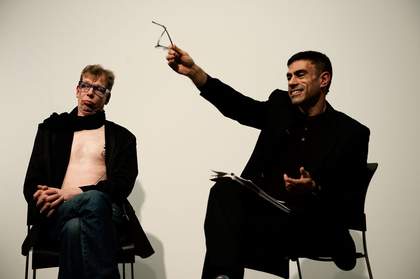Sex Mitigating Death: On Discourse and Drives: A Meditative Poem was a lecture-performance conceived by the American artist Gregg Bordowitz, exploring the French philosopher Michel Foucault’s theories on death and sexuality. Acting as the ‘academic’, Bordowitz walked to the front of the empty Tate Modern gallery, which had been laid out to resemble a lecture hall, and stepped behind a grey podium adorned with a skull. He then introduced ‘Professor Hoyle’, a fictional character played by the British performance artist David Hoyle who then began his performance. A year earlier Bordowitz had presented The History of Sexuality Volumes One, Two, and Three by Michel Foucault: An Opera at Museum Moderner Kunst (MUMOK) in Vienna. Sex Mitigating Death: On Discourse and Drives: A Meditative Poem pursued the same themes in the new form of a performance lecture.
Bordowitz’s introduction was addressed to the collected audience, but alluded to a fictive crowd of 800 people who were apparently desperate to hear the lecture. At one point Bordowitz even suggested to the audience that they could, or even should, leave half-way through to make room for those fictional masses outside. This hyperbole, coupled with Bordowitz’s claim that Professor Hoyle should need no introduction, gave the impression of a significant cultural figure akin to Foucault was about to speak. Hoyle – who wore a black jacket, scarf and trousers, but no shirt, leaving him bare-chested – performed something between a philosophy lecture, an epic poem and a theatrical monologue. He altered his tone from passage to passage, carefully accentuating both rhythm and rhyme and at times bursting into song. His camp, dramatic gestures appeared choreographed: pressing his hands together in front of his lips, gesticulating towards the audience, placing a hand over the skull on the podium, or throwing his hands up in the air in moments of passionate delivery. The concepts and subjects he spoke on – including sex, death, memory and dreams – repeatedly recalled Foucault’s philosophy. He finished by singing the phrase ‘Forever I will be a growing tree’ and held a final pose with his arms waving over his head, mimicking branches. He bowed to the applause that followed, nodding to the audience more in the manner of a theatrical actor receiving a standing ovation than an academic after delivering a lecture.
Following Hoyle’s lecture, Bordowitz returned to the stage to chair a question and answer session with Hoyle, who remained in character. This involved a few questions from Bordowitz and a number from the audience, with whom Hoyle formed a humorous rapport, all the time maintaining the confidence and certainty of the Foucault-like lecturer. He declared, in response to one question, that the lecture that evening would mean there was no more need for critical theory. Through Hoyle’s performance and Bordowitz’s staging, the audience was able to interrogate and discuss ideas offered by the now-deceased philosopher. Consequently this piece activated Foucault’s work for a younger generation and in a different context.
Bordowitz presented Sex Mitigating Death: On Discourse and Drives: A Meditative Poem as part of Tate Modern Live: Push and Pull (18–19 March 2011). Push and Pull was an event based on Alan Kaprow’s performance environment Push and Pull: A Furniture Comedy for Hans Hoffman 1963. In this piece, Kaprow installed furniture in two rooms and allowed the public to rearrange it in accordance with a set of instructions. The subtitle of the piece referred to the painter Hans Hoffman who famously taught many of the most distinguished American artists of the mid-twentieth century, including Kaprow. Hoffman used the phrase ‘push and pull’ to describe how a painter should create movement within a painting using contrasts of colour, form and texture. Kaprow repurposed this phrase from its original application in relation to painting and instead applied it to performance, transposing this theory from the flat canvas into a three-dimensional social space. The idea of expanding the use and implications of theory was central to the two-day Push and Pull event at Tate. Nine artists were invited by Tate, Tanzquartier Wien and MUMOK to investigate and explore history and theory through the medium of performance.1
These performances often incorporated elements of more traditional art media, such as sculpture, theatre and painting, to explore performance as a hybrid medium which often deals with issues, concepts and theories that fall between traditional categories. This idea was central to Bordowitz’s work, which took a predominantly written form of social philosophy and presented it through poetry, action and gesture using this model of transformation.
Acatia Finbow
October 2015

